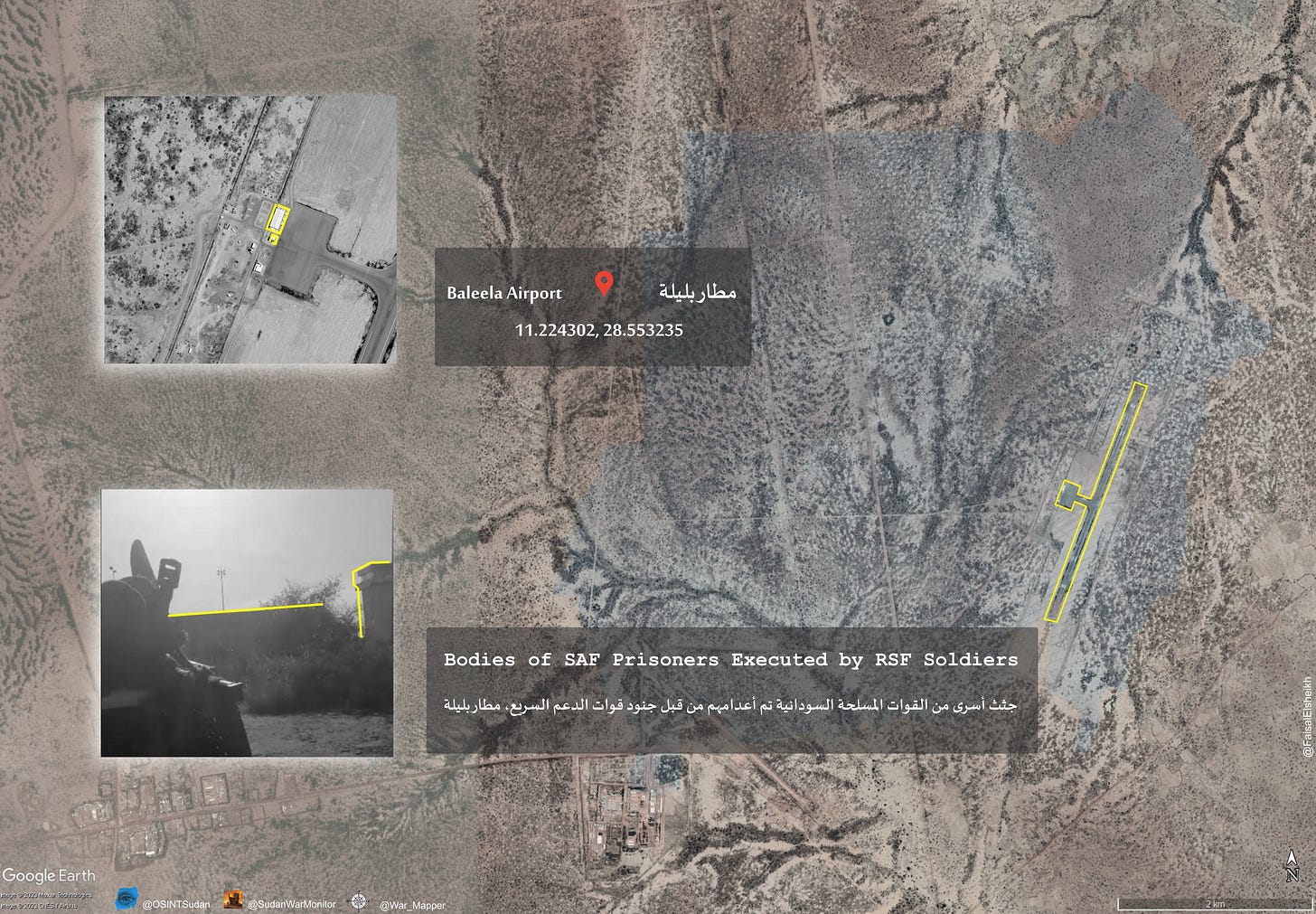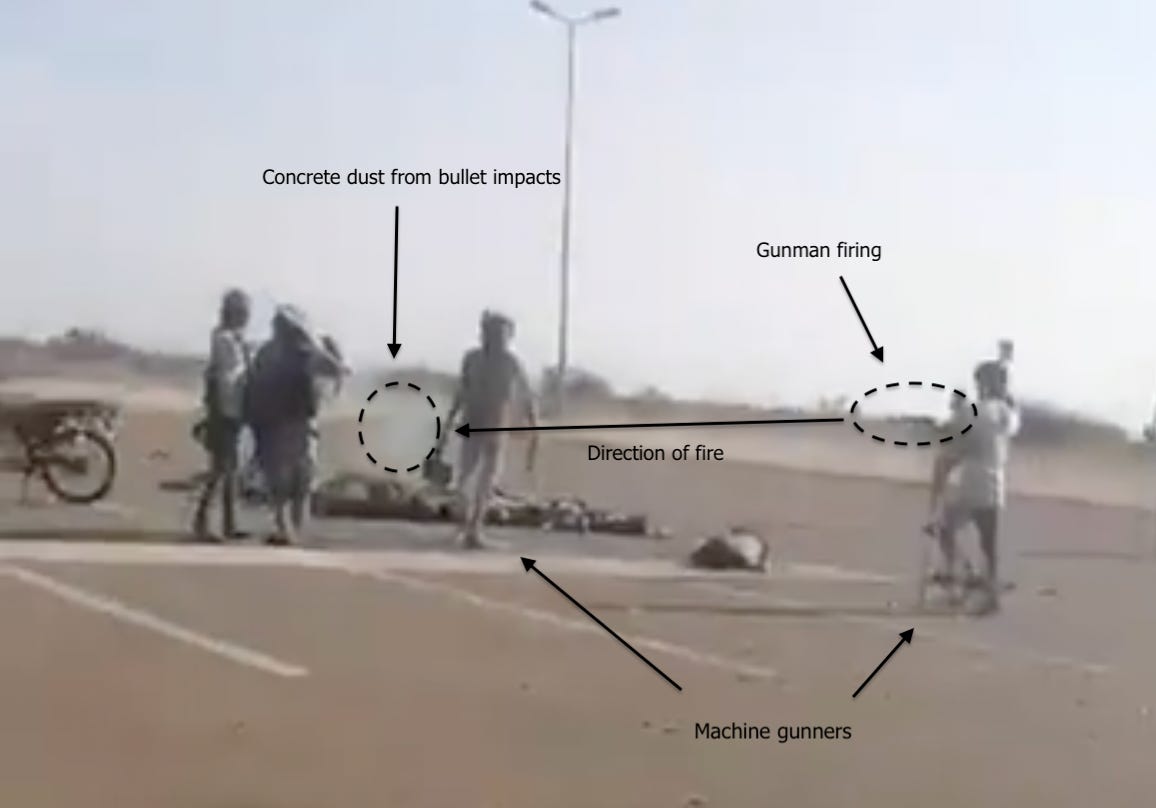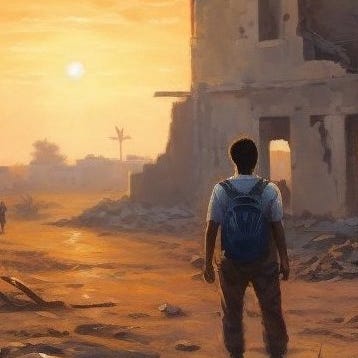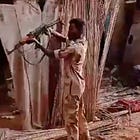RSF killed 14 prisoners in West Kordofan
Merciless execution of army troops captured by the RSF in Baleela
Members of the Rapid Support Forces killed 14 prisoners of war (POWs) in Baleela in West Kordofan, according to video evidence reviewed by Sudan War Monitor.
The massacre took place soon after RSF forces under the command of Hussein Barshom captured Baleela Airport on October 30, overrunning the defenders, who belonged to the Sudan Armed Forces (SAF).
While some of the defenders were killed during combat with the RSF, others surrendered. Subsequently, a group of 14 of them were gathered together at a parking lot behind the airport terminal, where they were forced to lie down, then shot.
Members of RSF filmed at least two videos from the scene. Geolocation confirms precisely where these videos were filmed (11.224302, 28.553235).
Our analysis of the videos points to the likelihood that the SAF prisoners were killed immediately prior to filming. Their bodies were not moved from other locations. We base this conclusion on the following observations:
There are bullet impacts around the bodies.
Gunfire is heard in one of the videos (Video #1), and one gunman is seen pointing a gun in the direction of the bodies.
Concrete dust is seen around the bodies while the shooting is ongoing.
There is no stiffness in the bodies (rigor mortis), nor any signs of decomposition, demonstrating they were killed very recently.
The blood on and around the bodies is bright red (oxygenated) rather than dark, and it had not dried, which means it was shed only recently.
There are no weapons around the prisoners.
This conclusion leads to a further conclusion, namely, that the 14 men were not killed during combat. If they had died in combat, they would not be lying so closely together, without weapons, out in the open.
Furthermore, the fact that nearly all of the men were found lying facedown in the same position suggests that the perpetrators forced them to lie down before they killed them. This hints at premeditation and coordination by a group of killers tasked to deal with the prisoners—not a mere crime of passion by one or two errant gunmen.
Description of Video #1
The first video of the massacre was filmed by an uninvolved member of the RSF. He was guarding another SAF prisoner nearby when he heard the shooting. He started filming and walked over to the scene, arriving just before the shooters stopped firing.
00:00 - The opening scene of the video shows a living prisoner sitting in the back of an RSF combat vehicle. A machine gun is heard firing nearby. The cameraman leaves the prisoner sitting in the truck and starts moving toward the sound of gunfire, passing several fighters on his way.
00:11 - The cameraman asks a passing fighter, “Did they kill them?” His response is not fully audible.
00:22 - Gunfire continues. The cameraman arrives at a parking lot behind the Baleela Airport terminal. There is an RSF combat vehicle and several fighters.
00:24 - A group of bodies comes into view. Sporadic gunfire is still heard. One or two gunmen are firing weapons at the bodies on the ground. Bullet impacts around the bodies kicks up concrete dust. Two machine gunners are also in view, though they appear to have stopped firing.
0:26 - A fighter holds up his hand, signaling to the other fighter(s) firing at the bodies to stop shooting.
0:30-0:45 - The cameraman approaches the bodies.
0:45 - A potential perpetrator carrying a machine gun appears on camera.
0:45-1:05 - Numerous bullet impacts are visible in the concrete, caused by bullets fired from the same direction from which the machine gunner came from.

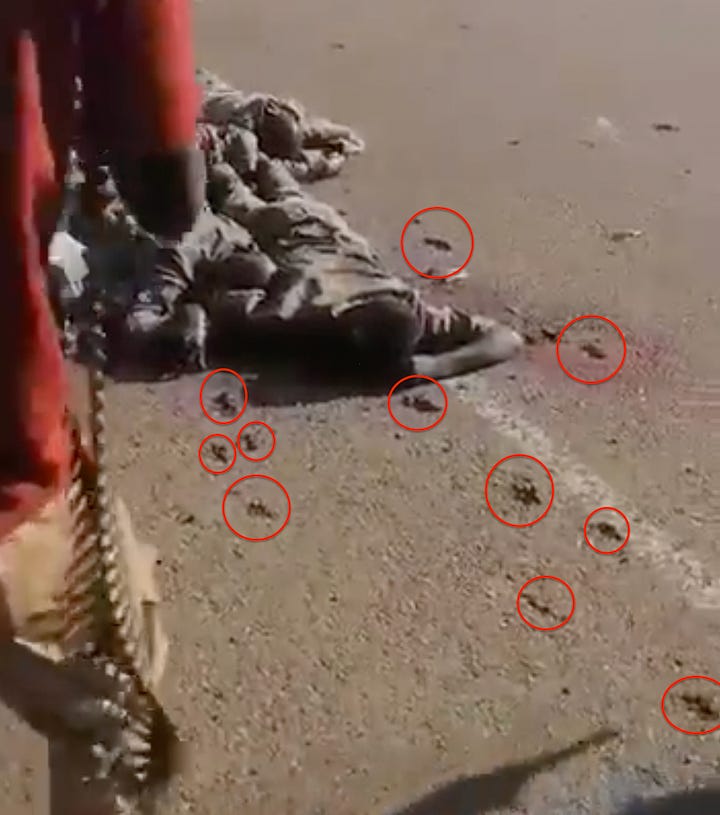
Bullet impacts around the bodies of SAF prisoners
0:55-1:39 - The cameraman walks around the bodies filming. All of them wear SAF uniforms. There is fresh blood and terrible wounds. None of them appear to be alive.



In total, there are 14 bodies.
01:42 - The film ends as the cameraman starts walking away. The cameraman says little during the video and he doesn’t celebrate the killings.
Video #1
Viewer discretion strongly advised (gunfire, gore, dead bodies)
Description of Video #2
The second video shows RSF soldiers celebrating the killing of the prisoners. Occasional gunshots are heard nearby, possibly celebratory gunfire or ongoing combat. One of the fighters holding a knife says “This is your army, Burhan.”
Video #2
Viewer discretion strongly advised (gore, dead bodies, strong language)
This is not the first time that the RSF have killed prisoners of war. We have previously documented incidents of confirmed or suspected killings in Omdurman.
Killing a prisoner of war is a war crime under both Sudanese and international law. The Third Geneva Convention states,
“Prisoners of war must at all times be humanely treated. Any unlawful act or omission by the Detaining Power causing death or seriously endangering the health of a prisoner of war in its custody is prohibited, and will be regarded as a serious breach of the present Convention…
Prisoners of war must at all times be protected, particularly against acts of violence or intimidation and against insults and public curiosity.
Measures of reprisal against prisoners of war are prohibited.
In addition to the 14 people killed in the above Baleela, at least three more SAF soldiers were killed nearby, though it’s unclear if they died in combat or after surrendering, according to a third video.
Photos of a senior commander killed in the area also circulated online, bringing the death toll from the Balila attack to at least 18—though this is just the number of deaths we visually confirmed; the full toll from the attack could be significantly higher.
At least three prisoners survived the attack on Balila, according to videos of POW interrogations reviewed by Sudan War Monitor.
Sudan War Monitor is independent and unaffiliated—we report both sides
We do this work because we believe that journalism is one accountability mechanism that can ultimately contribute toward peace and justice—however distant that hope may be. Unlike the propagandists on either side of this war, we tell the full story—not just one side—and we don’t fabricate and mislead. Not only have we reported about war crimes by the RSF, but also war crimes by SAF.
You can support our work by signing up for a free or paid subscription, by sharing this article on social media, or by emailing it to a colleague or friend. Note that our articles often are graphic and disturbing and are not suitable for all audiences.


